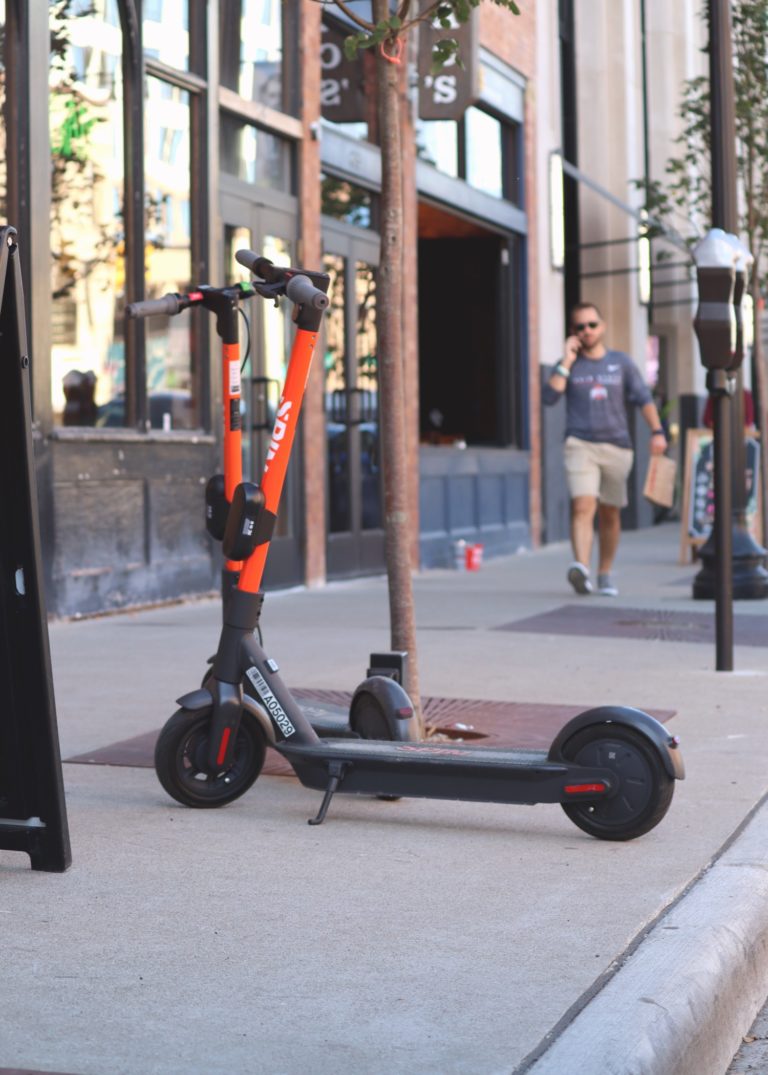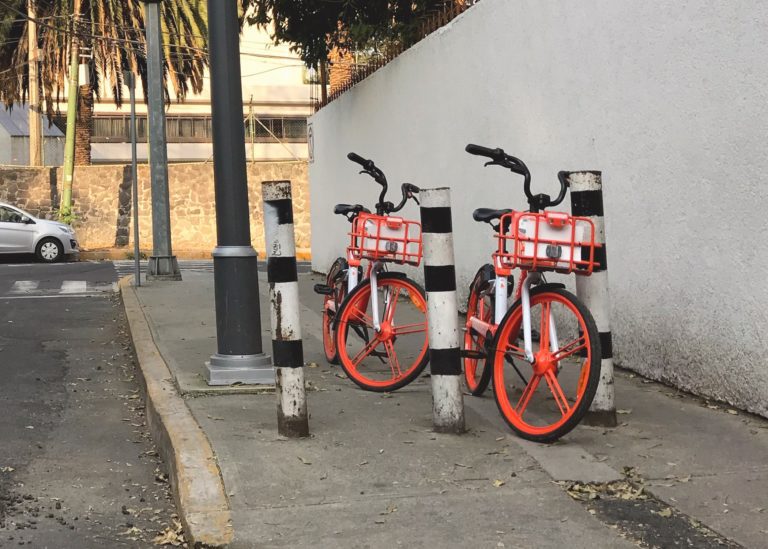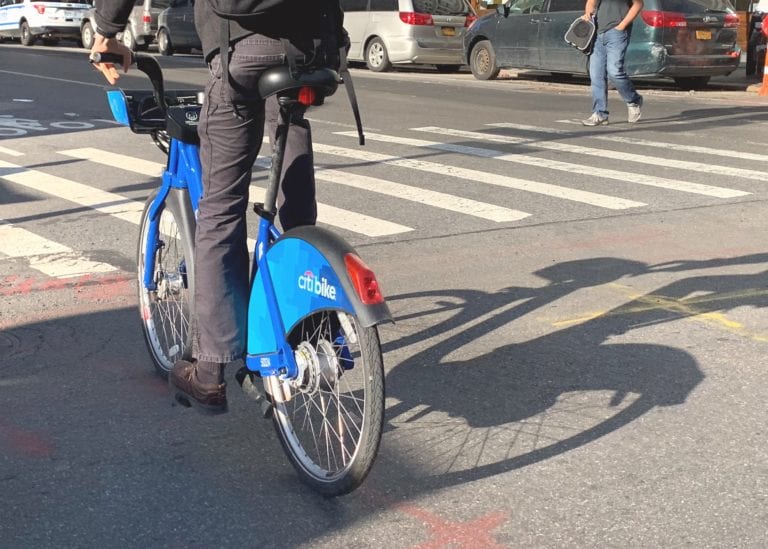Micromobility services and their use have rapidly grown

With the introduction of new micromobility services such as bikesharing and electric scooter sharing in the past few years, micromobility options have rapidly grown to become firmly entrenched in our cities as viable transportation options.
NUMO’s (the New Urban Mobility alliance) New Mobility Atlas1 shows that in just a few years since their inception, free-floating shared micromobility services are already operating in 630 cities in 55 countries around the world. In the United States alone, according to the National Association of City Transportation Officials (NACTO)2, 84 million trips were taken using shared micromobility services in the United States during 2018, more than double the number of trips taken in 2017. Of those 84 million trips, just over 45% were taken on shared electric scooters (38.5M), eclipsing in only one year the total number of trips on station-based bikeshare systems (36.5M), some of which have been around for the better part of a decade. These new shared micromobility services and vehicle form factors are already playing a significant and growing role in each of these communities. These new services, along with others still to come, have the potential to become an important element in the evolving mobility ecosystem.
As these services continue to evolve, mature and transform the mobility landscape of our communities, it’s increasingly important to better understand how they are reshaping our communities. Early evaluations3 show that micromobility services are already having an influence and changing our travel behaviors. Yet questions remain about trip patterns, which travel modes riders are shifting to and from, how best to protect and provide safe spaces for this burgeoning group of vulnerable road users, if services are increasing equitable access, and the real environmental impacts of micromobility.
Thankfully, these new services are also generating myriad new types of data that can help us understand how micromobility services are benefiting, impacting and integrating into our communities and existing transportation networks. These services, and the data they generate, offer one of the first opportunities in decades to gain a richer look at what is really happening on our streets and in our public spaces. Of course, any data collection efforts must balance the benefits of increasing our understanding of these micromobility services and their impacts on our communities with the importance of user privacy.
This website explores and provides suggestions on how best to use micromobility data to support city efforts seeking to evaluate these new services (and others yet to come) against policy goals that foster safe, sustainable and inclusive communities. To help cities make sense of these data, we have prepared use cases designed to weigh the benefits and impacts of these new services while also minimizing data collection to preserve user privacy. And, given that these services are already operating on our streets, the lessons from these evaluations can provide valuable insights necessary to thoughtfully craft policies, plans and regulations that maximize the positive benefits of any new micromobility services while mitigating negative externalities.
- New Urban Mobility Alliance (NUMO), New Mobility Atlas, February 2020
- National Association of City Transportation Officials, Shared Micromobility in the U.S.: 2018
- City of Portland, OR – 2018 E-Scooter Findings Report



Process
To develop the content for this website, NUMO initially conducted a policy scan. The policy scan included a review of local regulations for micromobility services along with a number of pilot program evaluations to better understand current thinking and regulatory practice.
NUMO convened a working group comprised of stakeholders from cities, micromobility service operators, data aggregators, academia, and non-governmental organizations to review concepts gathered from the policy scan, propose ideas and provide feedback on the research and hone the content of this website. The diversity and breadth of experience provided by the working group ensured a range of perspectives and opinions, all of which are important when delving into the contentious topic of data.
In total, over 50 participants and reviewers contributed during the working group process and to the final website. Participating individuals and organizations can be found here.
Structure
Since the introduction of micromobility operations, cities across the country have endeavored to foster and shape these services to support city goals while also facing rapid change and unfamiliar business models.
Evaluating and understanding the data generated by these services is a necessary step toward identifying whether these services are helping or hampering city goals. Given the nascent stage of the micromobility industry, however, cities so far have mostly used operations and trip data generated by operators to track and learn how micromobility services are being used and determine if operators are complying with municipal regulations. As micromobility services proliferate, and as their use grows and evolves, different methods are becoming necessary for better evaluating how these services are directly contributing to outcomes desired by both cities and operators.
Cities can lead in strategically integrating micromobility services to achieve community-based, long-term outcomes by establishing clear targets, informed by partnerships with micromobility operators and other key stakeholders, for these services, and basing the data cities need directly on measuring these outcomes. This approach will not only assure outcomes are being tracked appropriately, but also that the data are used effectively while protecting the privacy of users.
To keep outcomes at the forefront of the process, this website has been divided into sections addressing the following common, high-level outcomes agreed upon by the working group:
For each of these outcomes, there are myriad use cases and metrics that could be created using available data. To simplify and prioritize, the working group identified example goals within each outcome area along with key questions to distill the possibilities down to what is thought to be most important at this point in the evolution of micromobility services. For each question, we have included “evaluation” metrics to measure progress toward the above high-level outcomes. Each section also includes example policy levers that are within cities’ purview to effect change on those outcomes, as well as “policy” metrics to measure whether those chosen policy levers are achieving their desired effect.
Though analyzing every question or metric offered in this website would be a daunting task for any agency or local government, the goal for the working group was to be as comprehensive as possible. Given the breadth and depth of the suggested metrics, it will be incumbent upon local governments and agencies to determine which metrics are most pertinent to the goals and outcomes they are prioritizing for their communities. When choosing metrics to apply locally, cities should account for the interconnected nature of all these outcomes as well as other factors not directly addressed in this website.
To help cities and agencies determine which data is most important to collect when developing a pilot program or permit regulations, Remix, has helped identify the specific data necessary to inform each metric throughout this website. It is important to note that the data identified for the proposed metrics within this website were chosen in an effort to minimize collected data, personally identifiable information (PII) and risks to privacy. While the underlying raw data collected from providers inherently contains privacy risks, no output from any metric included in this website should pose a risk to privacy in itself. In this case, the risk to privacy isn’t in the output of any specific metric, but in holding the raw data. But, to obscure individual trips, analysis should be framed over a large enough arc of time or geographic area that not only protects individual user privacy, but also allows for consistent findings across time and space. Local governments and agencies will need to make sure their data storage, access, management and security processes comport with their state and local data regulations.
Lastly, while data generated by micromobility services can provide new insights, there is much more that we desire to understand outside of the scope of data. At its best, micromobility data generated by services or provided through user surveys can only provide a partial picture. The missing pieces can only be illuminated by engaging local residents and interacting with riders directly through public meetings, personal conversations and other engagement strategies. And, given micromobility’s nascent stage, it will be important to confirm the data and any information gained from direct engagement with on-the-ground observation such as video analytics, count programs, etc. to ensure these findings comport with reality. It is also important to recognize that shared micromobility data on its own provides only a small portion of the larger transportation reality, as cars, trucks, transit and other motorized vehicles contribute the vast majority of trips in many cities.
Equity
Historically, vulnerable communities—those which include low-income households, people of color and anyone disadvantaged based upon ability, age or other factors—have repeatedly experienced inequitable shares of transportation benefits and a disproportionately higher share of negative transportation externalities.1
Research has frequently shown that lack of access to reliable and affordable mobility choices reduces access to employment2, education3 and healthcare4, thereby further exacerbating systemic inequities and reducing social mobility and the quality of life in historically underserved communities. A key responsibility for local governments or public agencies working with private mobility operators is to ensure any new mobility service is accessible and affordable to all without disproportionately impacting vulnerable communities.
Shared micromobility presents cities with an opportunity to increase and expand access (both directly and as first- and last-mile connectors to existing transit systems) but may also exacerbate inequalities if residents aren’t provided with awareness of or information regarding new services and how to use them, or these services are not affordable, accessible, reliable or physically available. Furthermore, as these services are not typically run by the public sector, the traditional tools cities have to ensure and measure equity-based outcomes generally are not present or, at minimum, must be rethought to reduce potential barriers to entry.
We call these equity-based outcomes Access to Necessities because they include those activities we believe to be necessities for all city residents. To help measure Access to Necessities, we have borrowed from and adapted Remix’s Mobility Brief: Micromobilityʻs opportunity to serve the underserved edges5. In this brief, Remix identified two key policy levers cities have at their disposal to shape operators’ involvement in increasing accessibility: Access to Platforms and Access to Vehicles. Access to Platforms is centered around measuring the ability for all residents, especially those in underserved communities, to access and understand how to use micromobility platforms, access timely and accurate vehicle availability information and the affordability of micromobility services. The second, Access to Vehicles measures how easy or difficult it is for residents to access available micromobility vehicles.
Lastly, to ensure the fair and just distribution of benefits and burdens in other policy areas, NUMO applied an equity lens when looking at other outcomes. To that end, NUMO has highlighted equity-based questions and metrics within other outcomes to provide cities with the ability to quickly determine if they are seeing disparate impacts and benefits across their community and meeting needs within underserved areas.
- Fleming, Kelly, Social Equity Considerations in the New Age of Transportation: Electric, Automated, and Shared Mobility, Journal of Science Policy & Governance Vol. 13, Issue 1, October 2018
- Raj Chetty, Nathaniel Hendren, The Impacts of Neighborhoods on Intergenerational Mobility I: Childhood Exposure Effects, The Quarterly Journal of Economics, Volume 133, Issue 3, August 2018
- Urban Institute, Student Transportation and Educational Access, 2017
- Syed ST, Gerber BS, Sharp LK. Traveling towards disease: transportation barriers to health care access, J Community Health. 2013
- Rachel Zack, “Mobility Brief: Micromobilityʻs opportunity to serve the underserved edges“, Remix, October 2018
Safety
A fundamental obligation of local governments and agencies is ensuring streets are safe for residents, riders and pedestrians of all ages and abilities.
The rapid introduction of new micromobility services and vehicle types in cities around the world has resulted in a surge of riders on streets, sidewalks and in public spaces. Early evaluations1 showed micromobility may also be attracting a new group of users—those without experience as vulnerable road users, which might include using a personal or shared bicycle. Many of these new riders may not have the know-how or experience to understand their vulnerabilities and the ways they might pose a safety risk to themselves or others.
Because emerging mobility services, business models and vehicle types are so new, there is much to learn about their operations, risks and safety. We are all still learning how best to protect vulnerable road users, including pedestrians, to keep them safe and maximize the full potential micromobility services offer. The best results will likely flow from a safe systems approach2—in which safety is a shared responsibility among those that design, build, operate and use the transportation system. Using that approach, numerous cities, agencies, operators and stakeholder groups are already partnering to improve and ensure the safety of micromobility users in their communities.
Under the safe systems approach, the working group identified four key policy levers cities have at their disposal: Infrastructure, Education, Observation and Enforcement and Vehicle Condition. Infrastructure is focused on the role of creating dedicated, protected spaces for micromobility use and parking to ensure the safety of pedestrians and riders of all ages and abilities. Education encompasses how riders and other road users understand micromobility regulations and risks as well as how to use and interact with micromobility vehicles safely. Observation and Enforcement is directed at reducing unsafe riding behaviors and overall safety incidents, facilitating hazard-free public spaces and better understanding the cause of safety incidents when they occur. Finally, Vehicle Condition aims to ensure shared micromobility vehicles are safe and physically able to withstand the rigors of everyday operations. Vehicle design and construction are also important considerations for safety as well as other outcomes. Since micromobility vehicle design is still in an early stage and measuring advancements in vehicle design is challenging, it will be vital to develop metrics to assess design iterations as they are introduced by the micromobility industry.
The proliferation of micromobility services offers a great opportunity to emphasize a safe systems approach and reevaluate the policy, planning and design priority we’ve repeatedly afforded automobiles despite how that priority often does not lead to safer, more equitable and more sustainable outcomes we desire. Micromobility modes are among the first introduced in decades that are organically reframing how we think about our streets and public spaces and consider how the majority of road users—car, bus and truck drivers—interact with pedestrians, bicycles, scooters and other new vehicle types.
Lastly, to better understand the various factors that contribute to micromobility safety, we must accelerate our understanding of crashes and be forthright about the causes, whether they are car/truck drivers, vehicle/device deficiencies, infrastructure-related, or vehicle user error. Many existing law enforcement and hospital reporting structures do not yet include micromobility, so cities, agencies and operators will need to coordinate with their local police and public health communities to accurately identify micromobility vehicle types and ensure effective tracking. Establishing those formal reporting structures will likely take time, thus frequent communication will be necessary to determine if any shifts or trends in safety are taking shape.
- City of Portland, OR – 2018 E-scooter Pilot User Survey Results
- Moving Beyond Zero, Vision Zero and the ‘Safe Systems Approach’
Environment
In 2018, transportation emissions accounted for over 24% of global CO2 emissions from fuel combustion1 and are expected to grow faster than any other sector. Cities are already playing a key role in reducing transportation emissions by taking greater steps than ever before2: instituting congestion pricing3, shifting transit and municipal fleets to all-electric vehicles4, restricting the use of diesel5 and other high-polluting vehicles6 in central city cores, requiring all-electric taxi fleets7, prioritizing walking and cycling and converting more rights-of-way to dedicated active transportation facilities8 among other efforts.
New mobility services, vehicle types and powertrain technologies are frequently introduced as promising solutions to reduce energy consumption, decrease harmful emissions and shift more people to using sustainable modes. This opportunity to divert trips away from higher-polluting automobiles, especially for short distance trips, is at the heart of why micromobility has such strong potential. With any new mobility service or vehicle, however, it is critical to evaluate and learn exactly what its environmental impacts are, how it compares to other travel modes and vehicles and how many trips are being added or replaced to truly gauge the overall environmental impact.
What we’ve already learned since micromobility’s introduction is that a different approach is necessary to assess the sustainability of micromobility vehicles accurately. Electric micromobility vehicles, as opposed to most other existing vehicles with internal combustion engines (cars, trucks and buses), are inherently different because the bulk of their negative environmental impact is in their manufacture, transport and during service-based operations9. It is not in the energy consumption from the daily charging and use of the vehicle itself.
As smaller, lightweight electric vehicles shift environmental impacts further upstream, we will need a new approach to capture the entire life cycle of the vehicle. Defining this life cycle will require a deeper dive and better understanding of something cities largely have not had to be concerned with: how vehicles are manufactured, how long vehicles last and the role of modular parts and batteries, how operators manage and maintain their vehicles and how operators charge and distribute their fleets as well as end of life and waste management challenges. There are valid questions about the ability and appropriateness of cities to regulate some components of that life cycle, but we must continue to learn more about these upstream impacts for the future. Today though, cities do have a few policy levers—Operations and Lifespan—that, when activated, can help reduce local environmental impacts. Operations refers to understanding and reducing the impacts associated with collecting, redistributing and recharging vehicles. Lifespan focuses on the local environmental footprint throughout the vehicle lifespan and takes into account how long on average vehicles are in service.
Today, there is no standardized vehicle life cycle assessment in existence, though a number of micromobility operators and NGOs are working on creating assessments. Along with a commitment from many service providers to increase transparency, newly available vehicle life cycle data has created a window of opportunity for total environmental impact of a vehicle or service to enter the public purview, allowing a fundamentally different perspective from which to evaluate new and future services and, hopefully, reevaluate existing vehicles and services.
If we believe that these vehicle form factors and services can play a significant role in meeting critical climate targets, then we must proceed carefully to avoid unfairly stifling these services, especially in comparison to more polluting incumbent modes such as cars and trucks, simply because we have access to more data and information on the newcomers.
- International Energy Agency, Tracking Transport – Analysis, November 2019
- Somini Sengupta and Nadja Popovich, “Cities Worldwide Are Reimagining Their Relationship With Cars” The New York Times, November 2019
- Erin Durkin and Lauren Aratani, “New York Becomes First City in Us To Approve Congestion Pricing” The Guardian, April 2019
- Amy Morsch Bailey, “Greening City Fleets”, Center for Climate and Energy Solutions, March 2020
- Alana Petroff, “Diesel ban in Hamburg: German city bars older cars and trucks from key roads”, CNN Money, March 2020
- “City of Amsterdam to ban polluting cars from 2030”, Reuters, May 2019
- “Emissions standards for taxis”, Transport for London, March 2020
- Adele Peters, “What happened when Oslo decided to make its downtown basically car-free?”, Fast Company, January 2019
- Workshop Summary: Life-cycle assessment of urban transport options, International Transport Forum, October 2019, Full Life-Cycle Assessment Report due May 2020

Compliance
When choosing to create any policy that involves a third-party operator, one of the challenges cities and agencies face is measuring whether or not operators are in compliance with municipal regulations. Ensuring that policies and regulations are being adhered to is important, and where appropriate, we have included some potential compliance metrics.
In light of the technical nature of compliance, the working group has largely left day-to-day operational compliance, like regulatory definitions of fleet size calculations, to partner organizations such as the SAE Mobility Data Collaborative, which recently published Data Sharing Glossary and Metrics for Shared Micromobility—a set of standardized compliance definitions to aid cities and operators in managing or complying with permit regulations. Along with this suggested guidance, cities and operators will need to work together to determine how to calculate compliance (such as decisions about including or excluding trips that only start, end, or pass through the service area or those with extra-short or extra-long durations that likely aren’t real trips) and should be agreed upon in advance of any deployment.
Micromobility Policies Reviewed
Atlanta, GA
Austin, TX
Barcelona, Spain
Chicago, IL
Dallas, TX
Denver, CO
Los Angeles, CA
Mexico City, Mexico
Minneapolis, MN
Paris, France
San Diego, CA
San Francisco, CA
Santa Monica, CA
Seattle, WA
Portland, OR
Washington, D.C.
Micromobility Evaluations Reviewed
Chicago, IL
Denver, CO
Mexico City, Mexico
Portland, OR
Santa Monica, CA
Seattle, WA
Washington, D.C.
Alejandro Schwedhelm, World Resources Institute
Aman Chitkara, World Business Council for Sustainable Development
Annie Chang, SAE International
Ashley Friedman, Populus
Ben Holland, Rocky Mountain Institute
Benjamin Welle, World Resources Institute
Brytanee Brown, City of Oakland, CA
Clarissa Cabansagan, TransForm
Colin Hughes, Uber
Chelsey Colbert, Future of Privacy Forum
Chris Cherry, The University of Tennessee, Knoxville
Claudia Adriazola-Steil, World Resources Institute
Craig Brownstein, World Resources Institute
Courtney Sung, Remix
Diego Canales, Populus
Dana Yanocha, Institute for Transportation and Development Policy
Danielle Elkins, City of Minneapolis, MN
Emily Eros, Shared Streets
Emma Vassallo, Grow
Francie Stefan, City of Santa Monica, CA
Fernanda Rivera, City of Mexico City, MX
Henry Greenidge, Cruise
Janet Lo, City of Toronto, ON
Jesse Coleman, City of Toronto, ON
Jaime Lees, Arlington County, VA
Joe Girton, Ride Report
Jascha Franklin-Hodge, Open Mobility Foundation
Joshua Johnson, City of Minneapolis, MN
Kelsey Finch, Future of Privacy Forum
Lauren Smith, Lyft
Luiz Alves, Grow
Laurence Wilse-Samson, Bird
Louis Pappas, Bird
Marisa Rodriguez-McGill, Lyft
Mark Sussman, OurStreets
Malia Schilling, Populus
Mike Wadhera, Skip
Marlo Sandler, Lyft
Miller Nuttle, Lyft
Mollie Pelon McArdle, Shared Streets
Melinda Hanson, Bird
Mohammad Tajsar, ACLU of Southern California
Marla Westervelt, Bird
Naomi Doerner, City of Seattle, WA
Rachel Zack, Remix
Paul White, Bird
Regina Clewlow, Populus
Ruoying Xu, Populus
Raphael Dumas, City of Toronto, ON
Russ Brooks, New Urban Mobility Alliance Advisor
Rebekah Watkins, Remix
Rob McPherson, Skip
Ryan Lanyon, City of Toronto, ON
Scott Kolber, Roadify
Shalin Mantri, Skip
Shagithya Deivendran, City of Toronto, ON
Sharada Strasmore, City of Washington, DC
Uttara Sivaram, Uber
Vicente Torres, Grow
Stefanie Brodie, Toole Design
Ted Graves, Bird
Tom Buehler, Skip
Tom Ciszek, Bird
Tom Santinelli, Bird
Vasco Mora, City of Lisbon, PT
Zabe Bent, National Association of City Transportation Officials